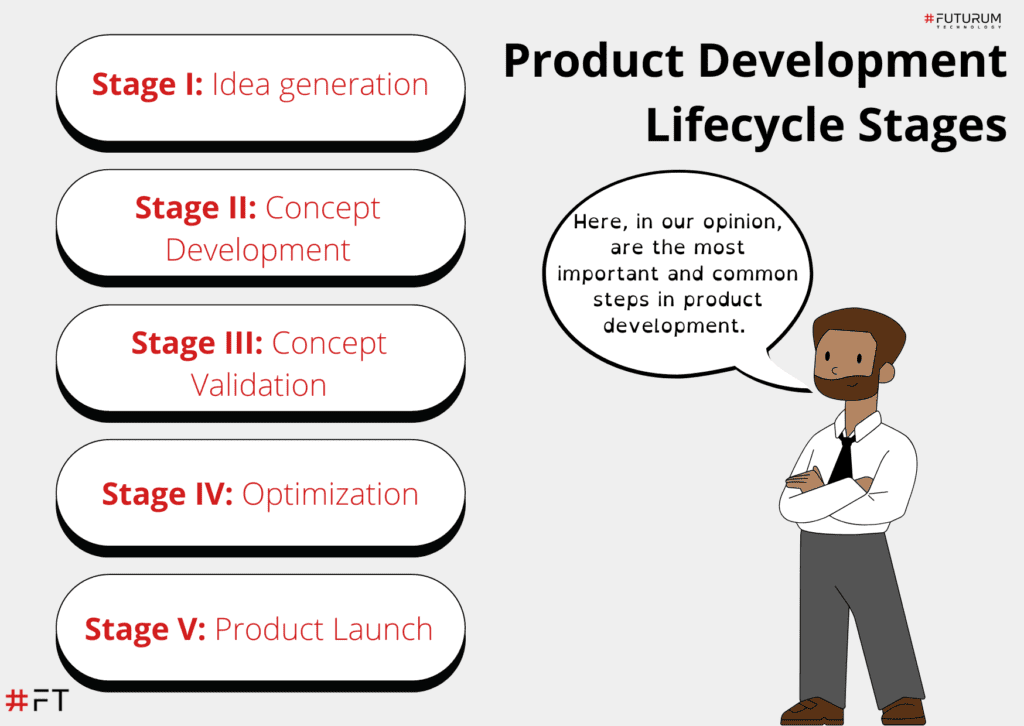This article discusses the five stages of product development and the importance of having a well-planned and implemented product development plan. It also highlights the difference between product development and product management. The five stages of product development are idea generation, concept development, concept validation, optimization, and product launch. If you want to know more, read the article!
Developing your start-up can be challenging but also thrilling. Especially-when you are ready to release a new product. The development process is different for every product, even when the steps of the product development lifecycle are the same. Product development is a very complex and individual process. But do not worry, today we would like to show you some common steps which may help you in releasing your new idea.
What is the lifecycle of product development?
Product development is the process of generating an idea for a product, developing it, and bringing it to market. The whole process is usually contained in five steps. In some books or websites, you may find six or even seven steps. It all depends on how we distribute our tasks.
A well-planned and implemented product development plan helps in releasing products on the market, makes communication easier and improves cross-functional cooperation.
Product development and product management: are these the same?
Even though these two concepts sound very similar, there is a difference between them:
- Product development is a multi-stage process of creating a product and bringing it to market.
- Product management concerns the mechanisms of guiding a team through the product development process, which involves overseeing a product’s entire lifecycle.
Both processes are very important, and they make up the product development strategy, which is crucial, especially for start-ups.

Product development lifecycle stages
It’s worth remembering that there is no universal idea of how the stages of product development should look like. It all is very individual and connected with the needs of start-ups and releasing products. However, there is a common, accepted series of steps that most products will pass in their lifecycle. Here, in our opinion, are the most important and common steps in product development.
Stage I: Idea generation
The first step is idea generation also called the ideation stage. Here, the start-up team will generate many ideas and thoughts about new products. The ideas may be based on different factors like clients’ needs, feedback, market research or concept testing.
In these steps, the most important is to generate as many new and innovative ideas as possible. So of them may be useless, but do not worry about that. Here is the amount of thoughts that count the most. Don’t think much about details, for that will be time later!
There are useful tools that may help you in brainstorming:
- User Personas let you define your target group and focus on a smaller group of ideas and products. Using personas may help you answer the based question, including what kind of users are you looking to build a product for?
- SWOT Analysis: Thanks to this tool you can easily describe the weaknesses, opportunities, strengths and threats of each idea.
Stage II: Concept Development
The second step is to narrow the ideas. It is a time when you have to decide which thoughts are good and which won’t work. The elimination process should be based on more detailed elements of each idea:
- Cost and pricing: How much would each idea cost to develop?
- Competition Evaluation: determine the potential of every product.
- Marketing strategy: mapping out a potential marketing strategy for new ideas.
Stage III: Concept Validation
In the third step, you focus on testing ideas. In that part, you should have two or three, of the best thoughts of all. And here is very crucial to build a minimum viable product – the earliest version of a product that is released with just the basic features that are needed for users to test it.
The purpose of that phase is to create the basic product as quickly as possible and release it immediately to start receiving users’ opinions.
Stage IV: Optimization
Another step is to optimize the product according to users’ feedback. Remember that every change even small in your product should be tested and collected more feedback. There are a few potential questions which may help you during asking your audience about the product’s opinion:
- How easy is navigating that product for the first time?
- How much the user be willing to pay for this product?
- In what kind of situation would you use that product?
Product optimization is crucial for every business. Changing and upgrading increases the chance that the product achieves product-market fit.
Stage V: Product Launch
The last step is launching the product to the market. You can do this in two ways. Release all features of the product at the same time or a phased launch, which may be beneficial for you.
Remember that launching a product does not mean that this is the end of the product development lifecycle. You still have to take care of the product and its optimization and upgrading. Regular product analytics can provide many useful solutions and insights into how individual product features are performing.
Understanding the product development lifecycle is very useful in start-ups. It helps with increasing product quality and efficiency and makes smoother development. As a company with works with start-ups every day, we recommend the five-stage of product development. We guarantee that it works and is effective.
If you have any questions about the product development lifecycle, write to us! If you want to know more about start-ups and how it works, check out our different article https://www.futurum.tech/blog/ and if you’re looking for something funny check out our TikTok https://www.tiktok.com/@futurumtechnology